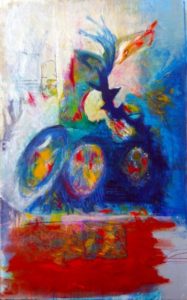 I am proudly intuitive in painting. I work hard NOT to think too much when I put pigment to canvas. Working intuitively nurtures the curiosity, surprise and wonder that make painting the valuable exercise it can be.
I am proudly intuitive in painting. I work hard NOT to think too much when I put pigment to canvas. Working intuitively nurtures the curiosity, surprise and wonder that make painting the valuable exercise it can be.
(Painting – to me, it’s a verb, not a noun; something you DO, not something you made. . . past tense intentional)
But intuitive does not mean without a plan. When you just let it all hang out you get junk. Or at least I do. I have painted over a dozen pieces this year that lacked any forethought or planning. I look at them and think, ‘Is this finished?’ I go away for a couple of days and then come back to face the truth: this is a cacophonous mess. Of course it is not finished! Out comes the white or the titan buff or the black Krink and another layer – one that DOES have some thought to it – goes on.
Planning happens in two places: up front, and at the end.
Up front, I have to choose a palette. I need three to five colors plus black and white to begin a piece. I think about it: what is my mood? Is it more brilliant or subdued? Is it subtle or glaring? Is it more red or blue; or maybe even yellow? While thinking, I often scroll through Instagram, Pinterest or other Internet collections of images for ideas – not about content, but about color.
When I finally pick up the brush, I am clear about mood and color. That much is structured. Now, I can shut down the thinking and skate on that river. I can wordlessly tear up the flat space universe that sits before me, fall into the canvas and swim there with my limited palette.
Layer after layer of line and color express themselves. The canvas is rotated and rotated again. Another canvas makes its way onto the easel and then another. Painting at times is a form of juggling!
And then I stop.
It’s the canvas, really, that makes me stop. At some point, the piece I’m working on raises its hand and says, ‘Wait a minute: look at this!’ I do, and often there is something there I want to develop, to enhance, to bring together. And that’s when planning returns to the process.
What is this piece about, I ask. What does it say to me? What stands in the way of that message – (be it a feeling or a statement)? What do I want to add and most important: what do I want to subtract. This is resolution. This is where the chaos of intuitive painting comes together to be something more than mess.
I have a friend who works in encaustic. His pieces are large and simple, but very powerful. He told me once that people sometimes look at his work and think he just whips them out one after another. ‘What they miss,’ he said, ‘is the hours and hours spent staring at the canvas trying to figure out what happens next.’ That is the planful process that makes intuitive painting worthwhile.
Personally, I don’t spend hours and hours staring at the canvas wondering what happens next. I used to, but I don’t now. Instead, I walk away or start another piece. I find if I just hold the painting and the process in my mind for a day or two and come back to it, what next becomes pretty obvious. And painting – the verb – becomes more fun.
